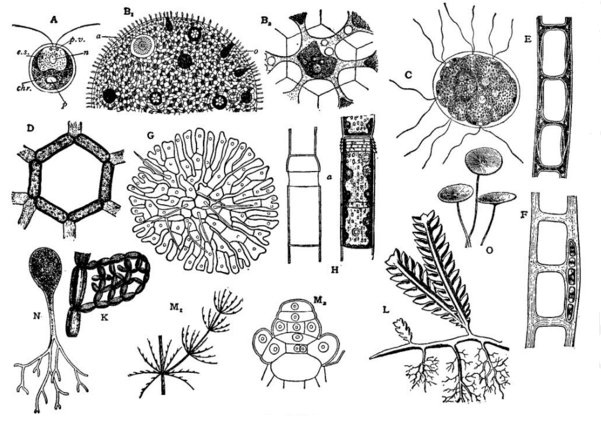Dermatophyton grows on the carapace of the tortoise and Trichophilus in the hairs of the sloth. Certain Protococcales and Confervales exist as the gonidia of the lichenthallus.

| A. Chlamydomonas sp., unicellular; chr., chromatophore; p., pyrenoid; n., nucleus; p.v., pulsating vacuoles; e.s., eyespot. B1. Volvox sp., with a, antheridia, and o, oogonia. B2. Volvox sp., surface view of a single cell showing connexions. C. Pandorina sp., a 16-celled colony. D. Hydrodictyon, a single mesh surrounded by 6 cells. E. Microspora sp., showing H-pieces in the wall. F.Entoderma sp., endophytic in Ectocarpus. G. Coleochaete sp., growing as a plate. H. Oedogonium sp., intercalated growth by insertion of new piece (a) leaving caps. K. Struvea sp., showing branches forming a net-work. L.Caulerpa sp., showing portion of axis with leaf-like and root-like appendages. M1. Chara sp., axis with leaf-like appendages and a branch. M2. Chara sp., apical region. N. Botrydium, a simple siphonaceous alga with root-like attachment. O. Acetabularia Mediterranea, mushroom-like calcareous siphonaceous alga. |
A, C, E, F, G, H, K, L, M1, M2 from Engler and Prantl, Pflanzenfamilien, by permission of William Engelmann; B1, N from Vines, Students’ Text Book of Botany,
by permission of Swan Sonnenschein and Co.; B2, D, O from Oltmanns, Morphologie u. Biologie der Algen, by permission of Gustav Fischer.)
The thallus is of more varied structure in this group than in any other. In the simplest case it may consist of a single cell, which may remain free during the whole of the greater part of its existence, or be loosely aggregated together within a common mucilage, or be held together by the adhesion of the cell-walls at the surface of contact. The aggregations or colonies, as they are termed, may assume the form of a plate, a ring, a solid sphere, a hollow sphere, a perforate sphere, a closed net, or a simple or branched filament. It is not easy in all cases to draw a distinction between a colony of plants and a multicellular individual. In a Volvox sphere, for example, there is a marked protoplasmic continuity between all the cells of the colony. The Ulvaceae, the thallus of which consists of laminae, one or more cells thick, or hollow tubes, probably represent a still more advanced stage in the passage of a colony into a multicellular plant. Here there is some amount of localization of growth and distinction of parts. It is only in such cases as Volvox and Ulvaceae that there is any pretension to the formation of a true parenchyma within the limits of the Chlorophyceae. In the whole series of the Confervales, the thallus consists of filaments branched or unbranched, attached at one extremity, and growing almost wholly at the free end. The branches end in fine hairs in Chaetophoraceae. In Coleochaetaceae the branches are often welded into a plate, simulating a parenchyma. In all Conjugatae and most Protococcales, and in the bulk of the Confervales, the thallus consists of a cell or cells, the protoplast of which contains a single nucleus. In Hydrodictyaceae, Cladophoraceae, Sphaeropleaceae and Gomontiaceae this is no longer the case. Instead of a single relatively large nucleus, each cell is found to contain many small nuclei, and is spoken of as a coenocyte. This character becomes still more pronounced in the large group of the Siphonales. Valoniaceae and Dasycladaceae are partially septate, but elsewhere no cellulose partitions occur, and the thallus is more or less the continuous tube from which the group is named. Yet the siphonaceous algae may assume great variety of form and reach a high degree of differentiation. Protosiphon and Botrydium, on the one hand, are minute vesicles attached to muddy surfaces by rhizoids; Caulerpa, on the other, presents a remarkable instance of the way in which much the same external morphology as that of cormophytes has been reached by a totally different internal structure. Many Siphonales are encrusted with lime like Corallina among Red Algae. Penicillus is brush-like, Halimeda and Cymopolia are jointed, Acetabularia has much the same external form as an expanded Coprinus, Neomeris simulates the fertile shoot of Equisetum with its densely packed whorled branches, and in Microdictyon, Anadyomene, Struvea and Boodlea the branches, spreading in one plane become bound together in a more or less close network. Characeae are separated from other Chlorophyceae by a long interval, and present the highest degree of differentiation of parts known among Green Algae. Attached to the bottom of pools by means of rhizoids, the thallus of Characeae grows upwards by means of an apical cell, giving off whorled appendages at regular intervals. The appendages have a limited growth; but in connexion with each whorl there arise, singly or in pairs, branches which have the same unlimited growth as the main axis. There is thus a close approach to the external morphology of the higher plants. The streaming of the protoplasm, known elsewhere among Chlorophyceae, is a conspicuous feature of the cells of Characeae.
The Chlorophyceae excel all other groups of algae in the magnitude
